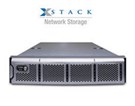D-Link Canada Now Shipping 8-Terabyte Capacity xStack iSCSI Storage Array

Oakville, ON - D-Link Canada recently began shipping its xStack Storage Area Network (SAN) Array with 8-terabytes storage capacity for entry-level and small-to-midsized businesses with expanding needs to store and backup valuable data.
The new DSN-2100-10 SAN Array is based on D-Link's powerful integrated iSCSI System-on-a-Chip (SoC) design found in larger arrays such as the D-Link DSN-3000 series of products, but housed in a smaller 2U chassis and priced less than competing products.
In addition to the SoC solution that can handle more than 80,000 input/outputs per second, other primary features include four 1-Gigabit Ethernet ports, an embedded disk controller supporting RAID Levels 0, 1, 1+0 and 5, and the 8 terabytes of drive capacity with current 1TB hard drives (and higher capacities when available).
According to Jerry Balice, vice president of technology for D-Link Canada, "The DSN-2100-10 SAN Array can easily be implemented as near-line storage or as a supplement to a primary backup and recovery device. This evolutionary advancement in performance is a testament to the tightly integrated xStack Storage architecture, and is a sharp contrast to the discrete implementation of competing products."
By utilizing existing Ethernet technology, Balice adds, the cost associated with separate host bus adapters and the per-Gigabyte cost for storage is significantly reduced. iSCSI SANs can leverage the Ethernet infrastructure and standards that are familiar to the technical staff.
Other Key Features:
- Four 1GbE Interfaces - All four ports can be grouped together, totaling up to 425 megabytes of bandwidth, for increased throughput and redundancy.
- SoC Implementation - Networking and storage functions are combined in a single chip, eliminating interoperability, timing and support issues found in competitive products.
- Embedded Centralized Storage Management - A user-friendly IP-SAN Device Manager (IDM) is a suite of utilities that allow monitoring and control of the SAN via the Storage Management Initiative Specification (SMI- S) command set.
- Cache Management - This provides write-back, write-through, write coalescing and multi-stream read ahead on a volume basis to optimized performance.
- VLAN Zoning - IEEE 802.1q VLAN tagging is supported to segregate traffic into isolated zones for secure access and jumbo frames to improve network throughput and reduce CPU overhead.
- Volume Virtualization - Storage management software uses the concept of storage Extents, fundamental building blocks that enable features such as RAID, online capacity expansion and volume migration.
SOURCE: D-Link Systems, Inc.
